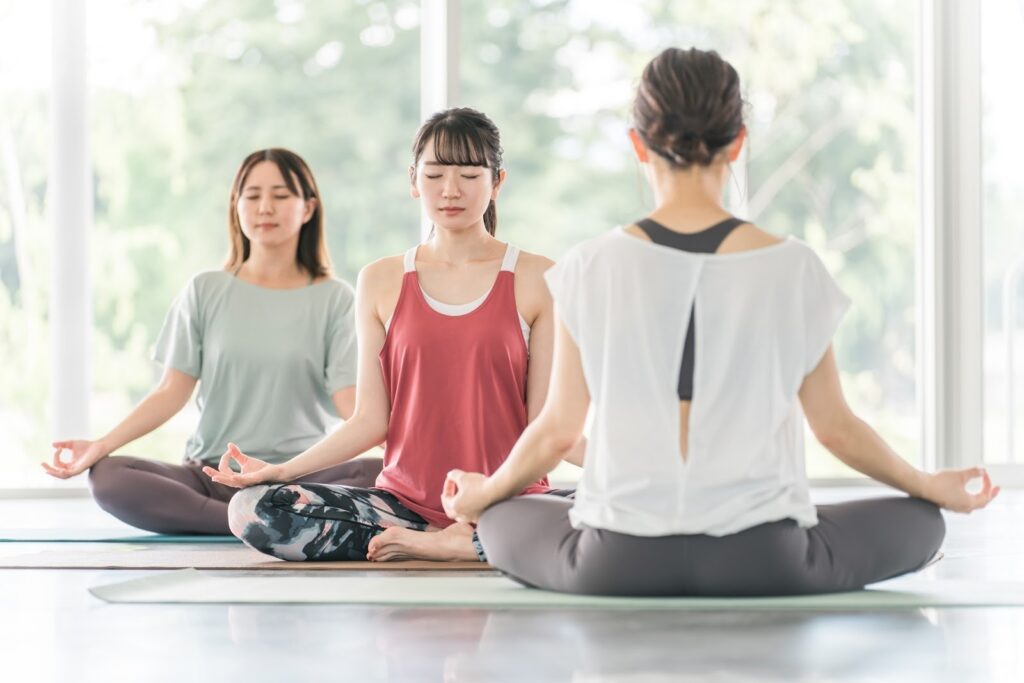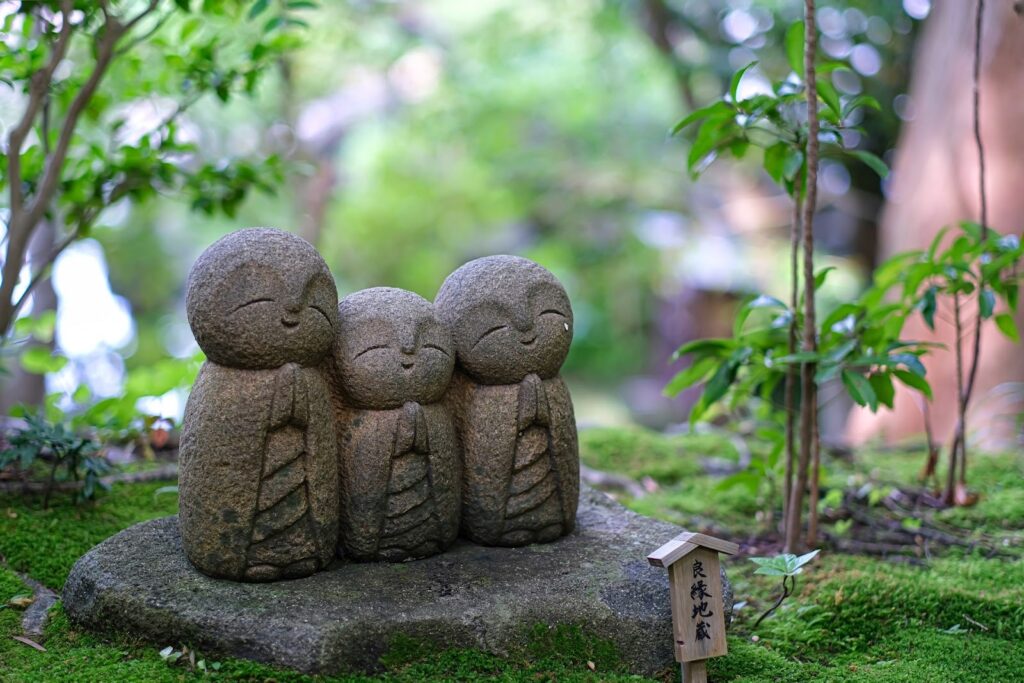Spiritual Retreat Near Me: Mindfulness and Inner Peace

Quick Summary
Searches for “spiritual retreats near me” are rapidly increasing as people in our noisy, hyperconnected world look for moments of quiet. These retreats combine mindfulness, meditation, and silence to restore focus and peace of mind. Whether at a Buddhist temple, a mountain meditation center, or in a quiet corner of your home with the Gassho mindfulness app, the path to inner stillness may be closer than you think.
- Mindful Escape: Science-backed methods for stress reduction and calming the nervous system
- Modern Silence: Digital detox for renewed attention and deep rest
- Spiritual Wellness: Spaces for reflection, healing, and connection
- Buddhist Connection: The Gassho practice and the ancient wisdom of “sound as stillness”
- Takeaway: The real retreat may be right beside you—or already within you
Introduction
We live in a world that never stops talking—screens glow, alerts ping, and our minds race to keep up. It’s no surprise that searches for “spiritual retreats near me” are surging. People aren’t running away from their lives; they’re searching for something they’ve lost—the feeling of silence.
Modern life pulls our attention outward. Work, messages, and social media demand constant engagement, leaving little room to simply be. Research from Harvard University has shown that excessive or chronic stress responses can keep cortisol levels elevated for long periods, disrupting the neural circuits that regulate emotion. This may explain why even a weekend away doesn’t truly ease our exhaustion—the brain has lost its place to rest.
What people are really looking for is not another vacation, but a way to rest while awake.
First, Let’s Begin with a Mindfulness Retreat

When people hear the phrase spiritual retreat, they often imagine prayer, introspection, or a religious experience. Yet the doorway to that experience is often a mindfulness retreat. As a practice of returning the mind to the present moment, many modern retreat traditions begin here. Let’s first explore what a mindfulness retreat truly means.
A mindfulness retreat is not about escaping daily life—it’s about re-entering it more deeply. It’s a consciously structured time to train attention, balance emotion, and reset the rhythm of the nervous system. Participants spend hours—or sometimes days—in silence, alternating between meditation, mindful walking, and conscious breathing.
From a scientific perspective, mindfulness practice is known to calm the amygdala—the brain’s “alarm center”—and strengthen the prefrontal cortex, which governs focus and self-regulation. Recent studies show that even a three-day residential mindfulness retreat can improve stress and inflammation markers (biomarkers: physiological indicators that reflect internal inflammation and stress responses). A 2021 study titled A Short Mindfulness Retreat Can Improve Biological Markers of Health (Psychoneuroendocrinology) reported measurable improvements in biological stress indicators after such short, intensive practice. These findings suggest that even brief immersion in stillness can restore balance and support mental and physical recovery. They challenge the common assumption that benefits require long-term or intensive training—showing instead that a few quiet days can realign the body’s stress response.
Typical retreat programs include guided meditation, mindful eating, gentle yoga, and digital detox. The goal isn’t to “become calm,” but to notice what calm truly feels like. As one teacher said: “You don’t meditate to escape your thoughts; you meditate to meet them kindly.”
What Is a Spiritual Retreat?

If a mindfulness retreat is a place to train awareness, a spiritual retreat is a place to remember meaning. It invites you to listen not only to your thoughts but to the deeper silence beneath them.
Spiritual retreats take many forms—silence, chanting, immersion in nature, prayer, or artistic expression. What unites them is not religion but resonance: the felt sense of connection to something larger, gentler, and timeless. Unlike escapism, a spiritual retreat is a return—a time to rest the body and renew the spirit.
Recent scientific studies also suggest that practices involving periods of silence and reflection— such as mindfulness or contemplative retreats—can reduce stress responses and restore emotional balance. This growing body of research supports what spiritual traditions have long known: that time spent in stillness fosters recovery, compassion, and a renewed sense of purpose. A retreat is not a place that gives you belief, but a space where you remember belonging—to yourself, to stillness, and to life itself.
How to Experience a Spiritual Retreat in Practice
A spiritual retreat doesn’t always require a monastery or a distant temple. You can create one wherever presence is possible. Begin by choosing a quiet space—perhaps your room at dawn or a nearby park. Silence your devices, slow your breath, and set an intention: to listen rather than to do.
Many modern retreats follow a simple rhythm:
– Morning: Gentle stretching or mindful walking to wake the body.
– Midday: Silent sitting or guided meditation focusing on breath or compassion.
– Evening: Reflection through journaling or chanting, allowing insights to settle.
If you prefer structure, apps like Gassho can guide you through short sound-based meditations inspired by Buddhist practice. Listening to chants or nature tones becomes a form of prayer without words. The essential rule: there are no rules. The point is to retreat from distraction, not from life. When you create pauses in your day—a few breaths before a meeting, a minute of stillness before sleep—you’re already practicing the art of spiritual retreat.
Gassho — The Buddhist Art of Stillness and Sound

In Buddhism, a retreat is not an escape from the world but a return to its essence. That spirit still lives in Kongo Sanmai-in, a temple deep in Mount Kōya that has preserved the disciplines of meditation and sacred chanting for over a thousand years. The timeless sound and silence cultivated there became part of the inspiration for the modern Gassho app.
Each morning before sunrise, monks at Kongo Sanmai-in awaken and chant sutras—not as performance, but as presence. Every syllable becomes breath; every pause becomes meditation. Their voices rise and dissolve among ancient cedar trees, reminding us that silence is not the absence of sound, but the awareness within it. Traditional Buddhist retreats—such as sesshin in Zen or ango in monastic communities—offer a rhythm of silence, structure, and compassion training. Mindfulness extends through all actions: speech, movement, thought. Meals are taken slowly in gratitude; walking becomes prayer; cleaning becomes offering. Through awareness, the ordinary becomes sacred.
This disciplined stillness cultivates prajñā, the intuitive wisdom that sees impermanence without fear. It is not dogma but lived spirituality—an awakening to interconnection. Long before “spiritual retreats” became a wellness trend, Buddhism had already embodied this ancient art of mindful return. At the heart of this practice lies Gassho, the act of placing one’s palms together. It symbolizes the union of body and mind, self and world, sound and stillness. When monks chant in Kōyasan and their voices echo through the forest, it becomes sound as stillness—a vibration that recenters rather than distracts.
Modern neuroscience now affirms what Buddhist experience has long known: rhythmic vocalization slows the breath, activates the vagus nerve, and induces deep calm. Sound and silence are not opposites—they are two sides of one breath.
Carrying this same spirit into modern life is the Gassho mindfulness app. Its name comes directly from the gesture of Gassho—the joining of palms and presence. Through brief chants, natural sounds, and guided breathing recorded with monks of Kongo Sanmai-in,
it creates small digital retreats woven into your everyday moments. Instead of using your phone to escape the world, you use it to return— to the present, to peace, to yourself. That is the new form of stillness that Gassho offers.
Conclusion — Finding Stillness, Near and Within
You don’t have to travel far to find stillness. The nearest retreat may not be in the mountains—it might be in your breath, your pause, your palms joined in Gassho.
Most people begin their search for a spiritual retreat near me by looking outward—for temples, mountains, or teachers. Yet every authentic retreat eventually turns inward. The distance you travel on a map matters less than the distance you travel within yourself. Silence, when entered with awareness, becomes the true destination.
You may visit a monastery or simply sit in your living room; both can open the same door if your attention is sincere. The essence of retreat is not where you go, but how you arrive—in stillness, in humility, in the company of your own breath.
Science shows that even short mindfulness retreats recalibrate stress circuits and enhance emotional balance. Yet beyond the data lies something quieter—the relief of coming home to yourself.
A spiritual retreat isn’t always a destination; sometimes it’s a decision. The decision to pause, to listen, and to let silence teach what words never could.
You don’t need to go far for a spiritual retreat. You just need to arrive where you already are.
Frequently Asked Questions

FAQ 1: What happens at a spiritual retreat?
Answer: A spiritual retreat typically includes meditation, silence, and reflection. Many centers integrate yoga, mindful walking, or chanting to help participants slow down and reconnect with inner awareness. Meals are simple, schedules are gentle, and conversation is often optional. The point isn’t withdrawal from life—it’s rediscovery of how to live with attention and compassion.
Real Results: A one-week spiritual retreat showed significant changes in brain functional connectivity, suggesting measurable neurological impact. (MDPI).
Takeaway: Stillness isn’t isolation; it’s integration.
FAQ 2: How do spiritual retreats differ from mindfulness retreats?
Answer: Mindfulness retreats train attention through secular meditation and awareness of the present moment. Spiritual retreats, while similar in structure, emphasize meaning, connection, and inner transformation. You might sit in silence at both, but one invites clarity while the other invites communion—with yourself and with the sacred dimension of life.
Real Results: A systematic review found that spiritual/religious practices (including retreats) involve measurable neurobiological correlates, linking meaning and brain changes. (ScienceDirect).
Takeaway: Mindfulness clears the lens; spirituality lets you see through it.
FAQ 3: Are spiritual retreats supported by science?
Answer: Yes. Neuroscience and psychology increasingly validate contemplative practices once considered purely spiritual. Mindfulness and compassion training have measurable effects on neural plasticity, emotion regulation, and immune response. While the language of “spirit” differs, the outcomes—calm, clarity, and connection—are universal.
Real Results: Harvard researchers at Massachusetts General Hospital and Harvard Medical School are actively studying how mindfulness meditation changes brain activity, with evidence of structural and functional brain changes.
Takeaway: Science and spirit are not opposites—they’re two languages for peace.
FAQ 4: Do I need to be religious to join a spiritual retreat?
Answer: Not at all. Modern retreats welcome all backgrounds. Spirituality in this context means wholeness, not worship. You’ll find participants who identify as Buddhist, Christian, atheist, or simply curious. The focus is on experience—on breathing, being, and belonging—rather than belief.
Real Results: Research shows neural circuits underlying spiritual dispositions are present independent of specific religious traditions. (Neurospirituality).
Takeaway: You don’t need faith to find stillness; just willingness.
FAQ 5: Can digital tools like the Gassho app replace physical retreats?
Answer: They can complement, not replace, them. Physical retreats provide immersion, while apps like Gassho offer daily micro-retreats. Each moment of mindful listening—a chant, a breath, a pause—strengthens the same awareness cultivated in monasteries. The future of mindfulness may not be in distant mountains, but in how we use our devices to return home.
Real Results: A review found that structured mindfulness and relaxation interventions effectively change cortisol levels, showing that even non-immersion formats yield physiological benefits. (ScienceDirect).
Takeaway: Technology can distract you—or bring you back. The choice is mindful.
FAQ 6: How long should a spiritual retreat last?
Answer: Retreats vary widely—from a single afternoon of meditation to ten-day immersions in silence. For beginners, two to three days often provide enough depth to reset body and mind without overwhelming the senses. The key is rhythm, not duration; even brief exposure to stillness recalibrates your nervous system. Consistency matters more than length.
Real Results: A study on a 3-day residential retreat found measurable improvements in biological stress markers. (ScienceDirect).
Takeaway: A few mindful days can renew weeks of scattered living.
FAQ 7: What do I bring to a retreat?
Answer: Bring comfortable clothing, an open mind, and a willingness to slow down. Most retreats supply cushions or mats, while silence, patience, and curiosity are your real essentials. Leave behind heavy expectations and unnecessary devices; the less you carry, the more you can hear.
Real Results: Simplified retreat environments reduce cognitive load and improve self-awareness.
Takeaway: Pack light—your awareness expands in proportion to what you release.
FAQ 8: Are there affordable or local retreats near me?
Answer: Absolutely. Many temples, wellness centers, and mindfulness organizations now offer donation-based or one-day retreats. Local community centres often host weekend mindfulness workshops, and some apps like Gassho collaborate with Buddhist temples for hybrid digital sessions. Spiritual stillness doesn’t require luxury—it requires intention.
Real Results: Community-based retreats have shown stress reduction outcomes comparable to more expensive resort-style retreats.
Takeaway: Peace of mind has no price tag; presence is free.
FAQ 9: Can beginners join a Buddhist or mindfulness retreat?
Answer: Yes, beginners are warmly welcomed. Most retreat leaders offer guided sessions explaining posture, breathing, and awareness basics. No prior meditation experience is needed—just curiosity and respect for silence. The beginner’s mind, unburdened by expectation, often receives the deepest insight.
Real Results: There are reports that first-time participants in guided retreats experienced noticeable decreases in anxiety and greater emotional balance.
Takeaway: Every master once sat down for the first time.
FAQ 10: What kind of meditation is practiced?
Answer: Most spiritual retreats use forms of mindfulness or insight meditation—observing breath, sensations, and thoughts without judgment. Buddhist settings may include chanting or compassion practices, while wellness retreats integrate body scans or nature walks. The unifying thread is presence: training attention to rest in “now.”
Real Results: A 7-day Zen retreat reduced brain activation related to attention-conflict tasks, increasing efficiency. (Frontiers)
Takeaway: Different techniques, same destination—stillness.
FAQ 11: Are silent retreats difficult?
Answer: Silence can feel unfamiliar at first. The mind resists emptiness, filling it with stories and restlessness. But as hours pass, awareness deepens, and sound itself becomes softer. Difficulty gives way to discovery—the recognition that silence was never empty but full of yourself, finally undistracted.
Real Results: Participants in silent retreats report increased clarity and self-compassion. (SpringerLink).
Takeaway: Silence begins as challenge and ends as homecoming.
FAQ 12: How do retreats help reduce stress and anxiety?
Answer: By removing constant input and restoring natural rhythm, retreats reset the autonomic nervous system. Meditation lowers cortisol and enhances parasympathetic activity, guiding the body into deep rest. This physiological calm allows emotional repair and mental clarity to arise naturally.
Real Results: A review found that digital-detox and retreat-like settings improve sleep quality and structure, thereby reducing stress. (eudl.eu).
Takeaway: The body heals when the mind stops shouting.
FAQ 13: What’s the difference between a wellness retreat and a spiritual retreat?
Answer: Wellness retreats focus on physical rejuvenation—spa treatments, nutrition, and movement. Spiritual retreats, while also caring for the body, place greater emphasis on inner harmony and the rediscovery of meaning. Both may include physical activity, but if the former helps you align your muscles, the latter helps you align your purpose
Real Results: Research suggests that participants in spiritually oriented retreats report greater long-term well-being and life satisfaction compared to those attending primarily physical wellness programs. (Psychology of Religion and Spirituality, APA, 2020)
Takeaway: Wellness refreshes; spirituality transforms.
FAQ 14: Can couples or families attend together?
Answer: Many retreats offer programs for couples or families designed around mindful communication and connection. Sharing moments of stillness together can deepen empathy and reduce relational stress. However, in silent retreats that emphasize solitude, individual participation may be required—so it’s best to check the guidelines in advance.
Real Results: A review of mindfulness-based couples programs found increases in emotional attunement and relationship satisfaction among participants. (Mindfulness-Based Relationship Enhancement: Integrating Mindfulness into Couples Therapy, Journal of Marital and Family Therapy, 2004)
Takeaway: Shared silence can speak louder than words.
FAQ 15: How can I integrate what I learned after returning home?
Answer: Bring retreat principles into daily life through micro-practices: one mindful breath before coffee, silence before responding, gratitude before sleep. Set reminders through apps like Gassho to anchor awareness amid routine. True retreat begins when you re-enter the world differently.
Real Results: In the study A Short Mindfulness Retreat Can Improve Biological Markers of Stress and Inflammation, a three-day residential mindfulness retreat was shown to improve biological markers of stress and inflammation. The findings suggest that even brief periods of quiet reflection can foster both physical balance and inner clarity.
Takeaway: The real retreat is the life you return to mindfully.
FAQ 16: Are there health benefits from attending a spiritual retreat?
Answer: Yes. Retreats enhance sleep, immune resilience, and emotional regulation. By reducing sympathetic over-drive and inflammation markers, they create measurable improvements in overall well-being. Some participants report lowered blood pressure and improved mood for months afterward.
Real Results: A 5-day nature-based mindfulness programme showed improvements in self-regulation for stressed students. (mdpi.com).
Takeaway: Calm is chemical—it shows up in your bloodwork.
FAQ 17: Do I have to disconnect from my phone completely?
Answer: Most retreats encourage device-free periods, allowing genuine rest from digital noise. It’s less about strict prohibition and more about reclaiming attention. If full disconnection feels hard, try progressive limits—checking only at set times. Silence isn’t punishment; it’s permission.
Real Results: A meta-analysis found that digital-detox programmes significantly improved attention, stress reduction, and self-reflection. (Frontiers).
Takeaway: When you unplug, presence recharges you.
FAQ 18: What if I struggle with stillness or boredom?
Answer: Everyone does at first. Stillness reveals the mind’s constant motion, which can feel uncomfortable. Rather than resisting boredom, observe it—curiosity dissolves restlessness. Gently return to your breath, and the noise inside will soften. Awareness grows in the quiet moments we once avoided.
Real Results: Exploratory study found that accepting boredom during periods of no-digital-device use improved emotional resilience and attention spans. (mdpi.com).
Takeaway: Boredom is the doorway to deeper presence.
FAQ 19: How does Gassho reflect the essence of a spiritual retreat?
Answer: Gassho unites the body’s gesture with the mind’s stillness. By joining palms, you acknowledge inter-connection—between self and world, sound and silence. The app brings this sacred simplicity to everyday life, transforming moments of distraction into devotion. It’s a retreat that travels with you.
Real Results: Evidence suggests that combining sound-based meditation with tactile focus—such as the gesture of palms-together—enhances grounding and calm more quickly than silent practices alone.
Takeaway: When hands meet, worlds reconcile.
FAQ 20: How do I choose the right spiritual retreat near me?
Answer: Begin with your intention—healing, clarity, community, or silence. Research centres emphasising those values and check reviews for atmosphere and authenticity. Shorter, local retreats often provide depth without overwhelm. Listen to intuition; the right retreat feels like exhaling.
Real Results: Global participant surveys show that when a retreat’s format and intention align with the individual’s goals, transformational outcomes are far more likely.
Takeaway: The best retreat is the one that meets you where you are.
Related Articles
- Exploring the Sustained Impact of the Mindfulness-Based Stress Reduction Program: A Thematic Analysis. (Frontiers in Psychology)
An in-depth look at how long-term participation in MBSR continues to influence emotional balance, focus, and overall well-being. - The Mindfulness-Based Digital Wellbeing Retreat: An Interpretative Phenomenological Analysis. (ScienceDirect)
A qualitative study on how digital-detox retreats and mindfulness apps support modern seekers of peace and attention restoration. - Meditation Retreats: Spiritual Tourism and Well-Being Interventions. (ScienceDirect)
Examines Buddhist and mindfulness-based retreats as forms of spiritual tourism that foster inner transformation and global well-being. - 5-Minute Mindfulness Meditation with Gassho: A Simple Guide
Breathe with awareness and listen to the sound. A small moment of meditation to restore inner calm—right from your smartphone. - What Is Gassho? The Meaning and Practice of a Timeless Gesture
Introducing the mindfulness app Gassho.
